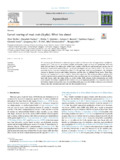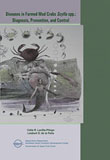Mass seed production of mud crab Scylla serrata at Rajiv Gandhi Centre for Aquaculture
| dc.contributor.author | Saravanan, M. | |
| dc.contributor.author | Arul Raj, S. | |
| dc.contributor.author | Manivannan, K. | |
| dc.contributor.author | Pandiarajan, S. | |
| dc.contributor.author | Thampi Sam Raj, Yohannan C. | |
| dc.contributor.editor | Quinitio, Emilia T. | |
| dc.contributor.editor | Estepa, Fe Dolores P. | |
| dc.contributor.editor | Thampi Sam Raj, Yohannan C. | |
| dc.contributor.editor | Mandal, Anup | |
| dc.date.accessioned | 2017-09-04T10:09:16Z | |
| dc.date.accessioned | 2017-09-04T10:41:08Z | |
| dc.date.accessioned | 2017-09-05T08:48:01Z | |
| dc.date.available | 2017-09-04T10:09:16Z | |
| dc.date.available | 2017-09-04T10:41:08Z | |
| dc.date.available | 2017-09-05T08:48:01Z | |
| dc.date.issued | 2015 | |
| dc.identifier.citation | Saravanan, M., Arul Raj, S., Manivannan, K., Pandiarajan, S., & Thampi Sam Raj, Y. C. (2015). Mass seed production of mud crab Scylla serrata at Rajiv Gandhi Centre for Aquaculture. In E. T. Quinitio, F. D. Parado-Estepa, Y. C. Thampi Sam Raj, & A. Mandal (Eds.), Proceedings of the International Seminar-Workshop on Mud Crab Aquaculture and Fisheries Management, 10-12 April 2013, Tamil Nadu, India (pp. 79-83). Tamil Nadu, India: Rajiv Gandhi Centre for Aquaculture (MPEDA). | en |
| dc.identifier.isbn | 9788192989815 | |
| dc.identifier.uri | http://hdl.handle.net/10862/3212 | |
| dc.description.abstract | Mass seed production of mud crab Scylla serrata adopting the best management practices has been done in the hatchery of Rajiv Gandhi Centre for Aquaculture, Thoduvai in Tamil Nadu. Mature female mud crabs from farms and landing centres were procured, screened for White Spot Syndrome Virus and conditioned in the hatchery. The crabs were subjected to unilateral eyestalk ablation whenever necessary and maintained in tanks with sand substrate and aeration. The crabs were fed fresh squid, oyster meat and low value fish. Hatching occurred 9 days after spawning. The newly hatched zoeae were stocked in 5-ton tanks at 80 ind/li. The larvae were fed rotifers and Artemia nauplii. Green water culture system with the use of probiotics was adopted. Enrichment of Artemia was carried out. A hatchery run ranged from 25-30 days. The highest survival rate achieved was 17.5%. This could propel the commercialization of mud crab seed production in India. | en |
| dc.language.iso | en | en |
| dc.publisher | Rajiv Gandhi Centre for Aquaculture (MPEDA) | en |
| dc.subject | Scylla serrata | en |
| dc.subject | Hatchery management | en |
| dc.subject | Green water system | en |
| dc.subject | Survival rate | en |
| dc.title | Mass seed production of mud crab Scylla serrata at Rajiv Gandhi Centre for Aquaculture | en |
| dc.type | Conference paper | en |
| dc.citation.spage | 79 | |
| dc.citation.epage | 83 | |
| dc.citation.conferenceTitle | Proceedings of the International Seminar-Workshop on Mud Crab Aquaculture and Fisheries Management, 10-12 April 2013, Tamil Nadu, India | en |
| dc.subject.asfa | hatcheries | en |
| dc.subject.asfa | eyestalk extirpation | en |
| dc.subject.asfa | eyestalk ablation | en |
| dc.subject.asfa | probiotics | en |
| dc.subject.asfa | survival | en |
| dc.subject.scientificName | Scylla serrata | en |
Files in this item
| Files | ขนาด | รูป | View |
|---|---|---|---|
|
There are no files associated with this item. |
|||
รายการนี้ปรากฏใน (s)
-
International Seminar-Workshop on Mud Crab Aquaculture and Fisheries Management (ISMAF 2013) [15]
Proceedings of the International Seminar-Workshop on Mud Crab Aquaculture and Fisheries Management, 10 - 12 April 2013



